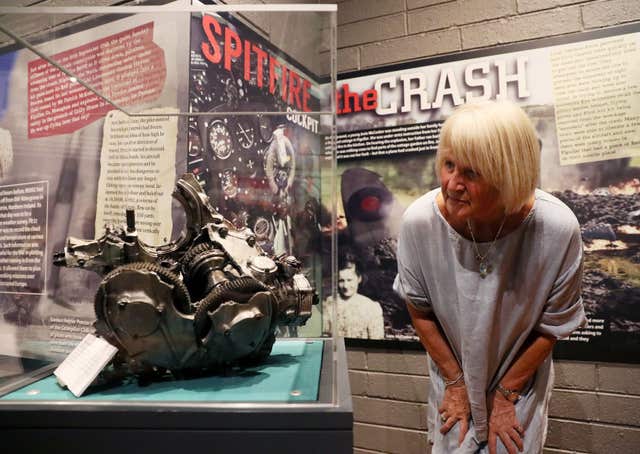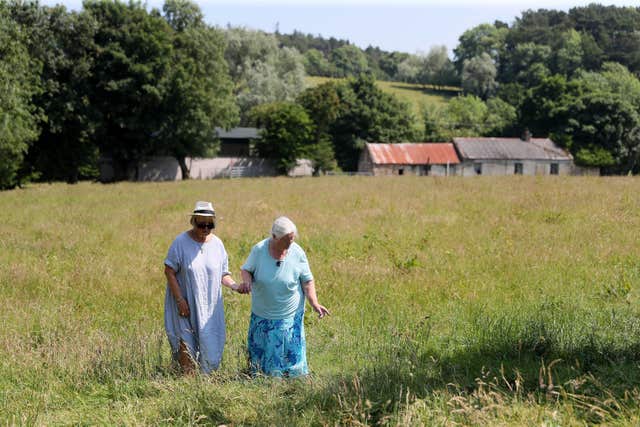
The family of a British war pilot have visited the spot where a Spitfire aircraft crash-landed in a field in Ireland.
Second World War pilot Lieutenant Gordon Hayter Proctor bailed out of the plane moments before it plummeted into the field in Co Monaghan.
The Spitfire crashed because of massive engine failure during a flight across Northern Ireland on September 20 1942.
The pilot’s niece Sarah Tysoe travelled from England on Thursday after local archaeologists uncovered parts of the Spitfire last year which remained buried in the field since WWII.
The aircraft’s engine are among some of the parts exhibited at Monaghan County Museum.
This summer, Monaghan County Museum hosts a fascinating new exhibition: The Monaghan Spitfire – Life on the Border with a World at War. Opening on 28th June 2018 and includes a real Spitfire and an anticraft gun outside Monaghan County Museum #MyMonaghan pic.twitter.com/eNNn31roqs
— MonaghanTourism (@MonaghanTourism) June 5, 2018
Liam Bradley, the museum creator, and aviation historian Jonny McNee were instrumental in locating and recovering parts of the RAF Spitfire.
Mr Bradley said: “The Spitfire suffered massive engine failure and the pilot bailed out.
“As the engine is so front heavy it flew on for a few minutes but once it lost power it dipped down almost at an 80-degree angle at 400 miles an hour.”
Most of the plane disintegrated on impact but the engine was buried some three metres below the surface.
The pilot parachuted out and landed a few miles across the border in Co Tyrone.
Mr McNee said: “The Spitfire crash is part of the local history.
“Everybody heard about it, lots of people went to the area and stole a bit of the plane before the Irish Army arrived.

“Proctor was flying with a meteorological flight that were based at RAF Aldergrove (Belfast). He would go up and take the temperature, humidity and air pressure.
“He did that two or three times a day and feed information back to the base.
“The first thing he did when he landed was bury his parachute as he didn’t know if he was in the North or South.
“The locals approached him, politely, with pitchforks. But they welcomed him and he had a bath and a meal and was able to ring his base.
“Some hours later he was back flying. He was an exceptional pilot.”
However, the pilot went missing in Burma in October 1944 and was never found.
Ms Tysoe described the visit as “surreal”.
“It’s amazing to actually see the spot, it’s indescribable,” she said.

“I’ve only known about this since February as when I watched Dunkirk I decided to search his name. So it was by pure chance that I came across all the articles.
“I got in touch with the museum and it’s been an amazing story for the whole family.
“It’s lovely for us to have him remembered in Ireland rather than his name on a memorial stone in Singapore.
“I had all the documentation from when he died and a few of his personal items but that’s all I knew.
“This has filled in many of the gaps of his life.”
Josie McCusker, who witnessed the crash as a five-year-old girl, said: “The noise was like thunder, it was very close to my house.
“The whole family rushed out to see what happened, it was very exciting.
“There were so many people who came to the field from near and far and loads of soldiers were about too.”
A life-size Spitfire, similar to the one that crashed some 15 miles outside Monaghan, went on display in the town on Thursday.


Comments: Our rules
We want our comments to be a lively and valuable part of our community - a place where readers can debate and engage with the most important local issues. The ability to comment on our stories is a privilege, not a right, however, and that privilege may be withdrawn if it is abused or misused.
Please report any comments that break our rules.
Read the rules here